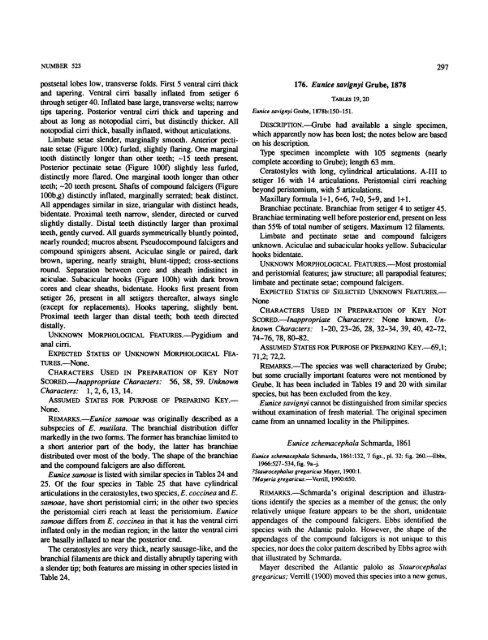A Review of the Genus Eunice - Smithsonian Institution Libraries
A Review of the Genus Eunice - Smithsonian Institution Libraries
A Review of the Genus Eunice - Smithsonian Institution Libraries
You also want an ePaper? Increase the reach of your titles
YUMPU automatically turns print PDFs into web optimized ePapers that Google loves.
NUMBER 523 297<br />
posiscial lobes low, transverse folds. First 5 ventral cirri thick<br />
and tapering. Ventral cirri basally inflated from setiger 6<br />
through setiger 40. Inflated base large, transverse welts; narrow<br />
tips tapering. Posterior ventral cirri thick and tapering and<br />
about as long as notopodial cirri, but distinctly thicker. All<br />
notopodial cirri thick, basally inflated, without articulations.<br />
Limbatc setae slender, marginally smooth. Anterior pectinate<br />
setae (Figure 100c) furled, slightly flaring. One marginal<br />
tooth distinctly longer than o<strong>the</strong>r teeth; -15 teeth present<br />
Posterior pectinate setae (Figure 1000 slightly less furled,<br />
distinctly more flared. One marginal tooth longer than o<strong>the</strong>r<br />
teeth; -20 teeth present. Shafts <strong>of</strong> compound falcigers (Figure<br />
100b,g) distinctly inflated, marginally serrated; beak distinct.<br />
All appendages similar in size, triangular with distinct heads,<br />
bidentate. Proximal teeth narrow, slender, directed or curved<br />
slightly distally. Distal teeth distinctly larger than proximal<br />
teeth, gently curved. All guards symmetrically bluntly pointed,<br />
nearly rounded; mucros absent. Pseudocompound falcigers and<br />
compound spinigers absent. Aciculae single or paired, dark<br />
brown, tapering, nearly straight, blunt-tipped; cross-sections<br />
round. Separation between core and sheath indistinct in<br />
aciculae. Subacicular hooks (Figure lOOh) with dark brown<br />
cores and clear sheaths, bidentate. Hooks first present from<br />
setiger 26, present in all setigers <strong>the</strong>reafter, always single<br />
(except for replacements). Hooks tapering, slightly bent.<br />
Proximal teeth larger than distal teeth; both teeth directed<br />
distally.<br />
UNKNOWN MORPHOLOGICAL FEATURES.—Pygidium<br />
anal cirri.<br />
EXPECTED STATES OF UNKNOWN MORPHOLOGICAL FEA-<br />
TURES.—None.<br />
CHARACTERS USED IN PREPARATION OF KEY NOT<br />
SCORED.—Inappropriate Characters: 56, 58, 59. Unknown<br />
Characters: 1,2,6,13,14.<br />
ASSUMED STATES FOR PURPOSE OF PREPARING KEY.—<br />
None.<br />
REMARKS.—<strong>Eunice</strong> samoae was originally described as a<br />
subspecies <strong>of</strong> E. mutilata. The branchial distribution differ<br />
markedly in <strong>the</strong> two forms. The former has branchiae limited to<br />
a short anterior part <strong>of</strong> <strong>the</strong> body, <strong>the</strong> latter has branchiae<br />
distributed over most <strong>of</strong> <strong>the</strong> body. The shape <strong>of</strong> <strong>the</strong> branchiae<br />
and <strong>the</strong> compound falcigers are also different.<br />
<strong>Eunice</strong> samoae is listed with similar species in Tables 24 and<br />
25. Of <strong>the</strong> four species in Table 25 that have cylindrical<br />
articulations in <strong>the</strong> ceratostyles, two species, E. coccinea and E.<br />
samoae, have short peristomial cirri; in <strong>the</strong> o<strong>the</strong>r two species<br />
<strong>the</strong> peristomial cirri reach at least <strong>the</strong> peristomium. <strong>Eunice</strong><br />
samoae differs from E. coccinea in that it has <strong>the</strong> ventral cirri<br />
inflated only in <strong>the</strong> median region; in <strong>the</strong> latter <strong>the</strong> ventral cirri<br />
are basally inflated to near <strong>the</strong> posterior end.<br />
The ceratostyles are very thick, nearly sausage-like, and <strong>the</strong><br />
branchial filaments are thick and distally abruptly tapering with<br />
a slender tip; both features are missing in o<strong>the</strong>r species listed in<br />
Table 24.<br />
and<br />
176. <strong>Eunice</strong> savignyi Grube, 1878<br />
TABLES 19.20<br />
<strong>Eunice</strong> savignyi Gnibc, 1878b:150-151.<br />
DESCRIPTION.—Grube had available a single specimen,<br />
which apparently now has been lost; <strong>the</strong> notes below are based<br />
on his description.<br />
Type specimen incomplete with 105 segments (nearly<br />
complete according to Grube); length 63 mm.<br />
Ceratostyles with long, cylindrical articulations. A-III to<br />
setiger 16 with 14 articulations. Peristomial cirri reaching<br />
beyond peristomium, with 5 articulations.<br />
Maxillary formula 1+1, 6+6, 7+0, 5+9, and 1+1.<br />
Branchiae pectinate. Branchiae from setiger 4 to setiger 45.<br />
Branchiae terminating well before posterior end, present on less<br />
than 55% <strong>of</strong> total number <strong>of</strong> setigers. Maximum 12 filaments.<br />
Limbate and pectinate setae and compound falcigers<br />
unknown. Aciculae and subacicular hooks yellow. Subacicular<br />
hooks bidentate.<br />
UNKNOWN MORPHOLOGICAL FEATURES.—Most prostomial<br />
and peristomial features; jaw structure; all parapodial features;<br />
limbate and pectinate setae; compound falcigers.<br />
EXPECTED STATES OF SELECTED UNKNOWN FEATURES.—<br />
None<br />
CHARACTERS USED IN PREPARATION OF KEY NOT<br />
SCORED.—Inappropriate Characters: None known. Unknown<br />
Characters: 1-20, 23-26, 28, 32-34, 39, 40, 42-72,<br />
74-76, 78, 80-82.<br />
ASSUMED STATES FOR PURPOSE OF PREPARING KEY.—69,1;<br />
71,2; 72,2.<br />
REMARKS.—The species was well characterized by Grube;<br />
but some crucially important features were not mentioned by<br />
Grube. It has been included in Tables 19 and 20 with similar<br />
species, but has been excluded from <strong>the</strong> key.<br />
<strong>Eunice</strong> savignyi cannot be distinguished from similar species<br />
without examination <strong>of</strong> fresh material. The original specimen<br />
came from an unnamed locality in <strong>the</strong> Philippines.<br />
<strong>Eunice</strong> schemacephala Schmarda, 1861<br />
<strong>Eunice</strong> schemacephala Schmarda, 1861:132, 7 figs., pi. 32: fig. 260.—Ebbs,<br />
1966:527-534, fig. 9a-j.<br />
Staurocephalus gregaricus Mayer, 1900:1.<br />
IMayeria gregaricus.—Merrill, 1900:650.<br />
REMARKS.—Schmarda's original description and illustrations<br />
identify <strong>the</strong> species as a member <strong>of</strong> <strong>the</strong> genus; <strong>the</strong> only<br />
relatively unique feature appears to be <strong>the</strong> short, unidentate<br />
appendages <strong>of</strong> <strong>the</strong> compound falcigers. Ebbs identified <strong>the</strong><br />
species with <strong>the</strong> Atlantic palolo. However, <strong>the</strong> shape <strong>of</strong> <strong>the</strong><br />
appendages <strong>of</strong> <strong>the</strong> compound falcigers is not unique to this<br />
species, nor does <strong>the</strong> color pattern described by Ebbs agree with<br />
that illustrated by Schmarda.<br />
Mayer described <strong>the</strong> Atlantic palolo as Staurocephalus<br />
gregaricus; Verrill (1900) moved this species into a new genus,
















